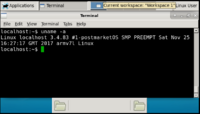Google Glass (Explorer Edition) (google-glass)
| WARNING: This device
is not recommended for future use with postmarketOS due to its armhf architecture. Alpine Linux (the distribution that postmarketOS extends) pmaports#599 has been considering dropping it. |
| This device is still running on armhf, although it supports armv7. If you own it, change it and test it that way. |
| This device runs a Downstream kernel. Some UIs will not work, and most features (3D acceleration, audio, etc.) may be broken. |
 Running Xfce 4 | |
| Manufacturer | Foxconn |
|---|---|
| Name | Glass (Explorer Edition) |
| Codename | google-glass |
| Released | 2013 |
| Type | glasses |
| Hardware | |
| Chipset | TI OMAP 4430 |
| CPU | Dual-Core 1.2 GHz Cortex-A9 |
| GPU | PowerVR SGX540 |
| Display | Prism projector, 640×360 pixels (equivalent of a 25 in/64 cm screen from 8 ft/2.4 m away) |
| Storage | 16 GB |
| Memory | 2 GB |
| Architecture | armhf |
| Software | |
Original software The software and version the device was shipped with. |
Glass OS |
Extended version The most recent supported version from the manufacturer. |
Glass OS |
| postmarketOS | |
| Category | downstream |
Mainline Instead of a Linux kernel fork, it is possible to run (Close to) Mainline. |
no |
| Device package |
|
| Kernel package |
|
Flashing Whether it is possible to flash the device with pmbootstrap flasher. |
Works
|
|---|---|
USB Networking After connecting the device with USB to your PC, you can connect to it via telnet (initramfs) or SSH (booted system). |
Works
|
Battery Whether charging and battery level reporting work. |
Untested
|
Screen Whether the display works; ideally with sleep mode and brightness control. |
Works
|
Touchscreen |
Partial
|
| Multimedia | |
3D Acceleration |
Untested
|
Audio Audio playback, microphone, headset and buttons. |
Works
|
Camera |
Works
|
| Connectivity | |
WiFi |
Works
|
Bluetooth |
Works
|
GPS |
Untested
|
| Modem | |
Calls |
Untested
|
SMS |
Untested
|
Mobile data |
Untested
|
| Miscellaneous | |
FDE Full disk encryption and unlocking with unl0kr. |
Works
|
| Sensors | |
Accelerometer Handles automatic screen rotation in many interfaces. |
Untested
|
Contributors
- kaendfinger
Maintainer(s)
How to enter flash mode
Note that the the device gives no indication of being in fastboot mode, just a blank screen.
Also note that fastboot devices may show no permissions in place of a serial number. If this is the case, you may need to run fastboot as root. If it still shows no permissions then you probably need to install the android udev rules package, AND copy the file to /etc/udev/rules.d/ AND add the Google Glass product ID to the Google vendor ID section. The Glass has at least 9001 and 9002 as adb and fastboot product identifiers.
Method #1
- enable debugging
adb reboot bootloader
Method #2
- power off device
- hold button
- press
- wait 10-15 seconds
(this method is somewhat tricky since pmbootstrap devices is the only way of determining if it was successful)
Method #3
- power off device
- enter recovery mode
- hold button
- press once
- continue holding button for 10 seconds
- select
Installation
Installation to flash seems to be challenging/broken at the moment, but pmbootstrap flasher boot does work to get pmOS running on the device, and you can access the device via SSH over USB networking to connect the wlan0 interface to a network using wpa_supplicant and then should be able to sudo apk add postmarketos-ui-i3wm if it didn't automatically start (which it didn't for dragon788).
Interesting notes
i3wm does work on the device, the touchpad on the temple is mapped like an absolute positioning mouse (emulates touchscreen behavior sort of). dragon788 was able to drag the i3wm initial config window to the center of the workspace, because it was way off at the far bottom right since it assumed a resolution higher than 640x360 (probably 800x600 or 1024x768 was the minimum the i3 guys expected).
SXMO doesn't show up as an option, possibly because the device is currently configured as armhf rather than arm7 so changing that per the note at the top of this page may open more options.
See also
- pmbootstrap!957 Initial merge request
- Wikipedia page